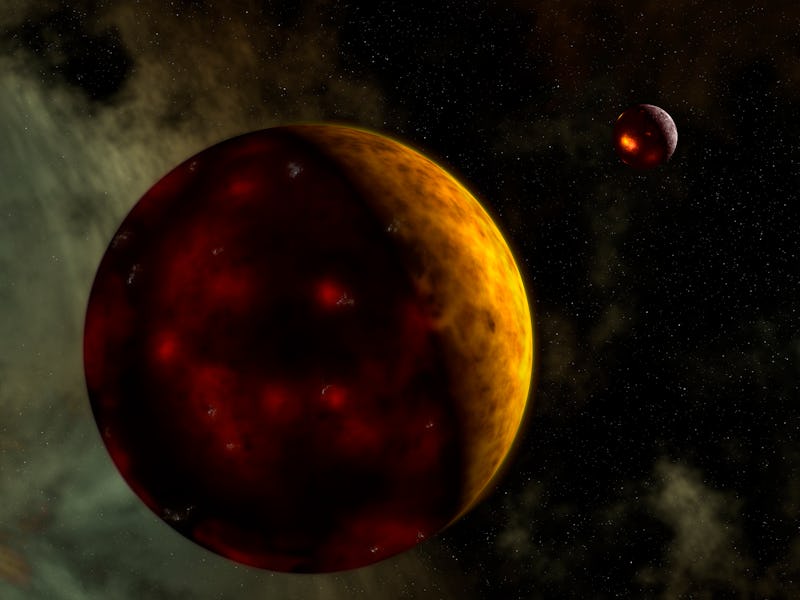A New Finding About Early Earth Could Broaden the Hunt for Alien Life
Methane helped keep early Earth warm, and a recent study suggests it could form on nearly any rocky planet with water.

Methane could form much more easily, and much more widely, on early Earth than scientists previously realized, according to a recent study in the journal Nature.
The chemical compound, made of carbon and hydrogen, is a greenhouse gas that helped keep early Earth warm enough for life. In recent experiments, microbiologist Leonard Ernst, of the Max Planck Institute for Terrestrial Microbiology, and his colleagues found that methane can form very easily through a set of chemical reactions triggered by sunlight in water. The researchers suggest that the same reactions should happen on any sunlit rocky planet, which could be good news for some worlds at the outer edge of their stars’ habitable zones.
A Greenhouse on Early Earth
Life seems to have emerged on Earth sometime around 3.7 billion years ago, during what’s known as the Archaean Period. Those earliest microbes lived on a rocky world lit by a much fainter, much younger Sun; during its younger days, the Sun only produced about three-quarters as much energy as it does today. Earth should have been a much cooler place — maybe even a frozen place. But all the chemical evidence in our planet’s oldest rocks suggests that Archaean Earth was at least as warm as it is today. Scientists call this the Faint Young Sun Paradox, and the likely explanation is a chemical called methane.
Methane is a greenhouse gas, like carbon dioxide, which means that it traps heat in Earth’s atmosphere and warms the surface of the planet. If our planet’s atmosphere contained enough methane during those early years, the surface could have been warm enough for liquid water to flow and life to form, despite the fainter sunlight.
Today, methane is a byproduct of life, but four billion years ago, there were no bacteria or cows to puff methane into the atmosphere. Instead, geologists suggest it could have been produced during a process called serpentinization, which happens when minerals from deep inside Earth’s crust come into contact with seawater, usually at deep-sea hydrothermal vents. Those reactions require lots of heat and pressure, so they can’t happen just anywhere.
The problem is that hydrothermal vents probably couldn’t pump out enough methane to keep the planet warm enough to be habitable. Ernst and his colleagues, in a recent experiment, found another way methane could have formed on the early Earth: a set of chemical reactions triggered by warmth or sunlight, which could have happened pretty much anywhere on the planet.
“These reactions may have shaped the chemical evolution of the atmosphere before the emergence of life,” write Ernst and his colleagues in their recent paper.
Broadening the Search for Habitable Worlds
Ernst and his colleagues were focused on early Earth, but their findings could suggest some new places to look for life, or at least hospitable conditions for life, on other planets.
It’s possible that these reactions could make the difference between a habitable planet and a slightly too chilly one. Extra greenhouse gas probably won’t hold in enough heat to turn an icy planet in the outer reaches of a star system into a second Earth. But for worlds hovering on the outer edge of the habitable zone, the area around a star where the temperature is just right for liquid water to exist on the surface of a planet, a blanket of methane and ethane could tip the balance.
“It could definitely contribute to rather cold worlds, making them a bit warm,” Ernst tells Inverse. “This might potentially be the difference between habitable and not habitable, just to have these sulfur compounds which [react to produce] methane and ethane.” However, he adds, that's “very speculative, of course.”
Meanwhile, the fact that methane forms so easily in reactions triggered by sunlight is yet another reason for astrobiologists to be careful about interpreting methane on other planets as evidence of life.
Today, livestock are a major source of methane, but it can also form thanks to geological processes or chemical reactions in water or the atmosphere. Methane consists of one carbon atom and four hydrogen atoms.
A New Recipe for Methane
According to Ernst and his colleagues, the process starts with positively-charged iron atoms, along with chemical compounds containing sulfur, carbon, and hydrogen. These sulfur compounds would have formed at hydrothermal vents or crash-landed on the young planet along with meteorites. The iron, meanwhile, would have been abundant in early oceans without much oxygen.
Sunlight and heat cause the positively-charged iron to react with hydrogen peroxide — something else that would have been readily available on early Earth. Those reactions, in turn, release particles that cause other reactions in the sulfur compounds floating nearby. The carbon and hydrogen in the sulfur compounds and the hydrogen peroxide gets turned into methane and ethane.
These reactions could have happened all over the planet – not just at deep-sea hydrothermal vents, but anywhere in the early Earth’s oceans, rivers, lakes, and ponds. And the same could be true on any Earth-like planet.
“This is so basic, I would predict it occurs on probably every rocky planet which might have some water and these methylated sulfur compounds,” Ernst says.